18. Working with Reports in QuickBooks
What You’ll Do
Looking at the Company Snapshot
Use the Improved Report Center
Set Report and Graph Preferences
Import and Export Report Templates
Understand Sharing and Contributed Reports
Learn about Other Report Tips and Tricks
Introduction
QuickBooks is all about reports. All the information you enter on forms, registers, and journal entries is stored in QuickBooks, waiting for you to pull it out in reports. Reports show you the results of all your company’s financial transactions. You can display reports, print them, save them, email them, and rely on the information they provide to show you how well your company is meeting your expectations.
QuickBooks comes with a large collection of reports to help you understand your business. You can customize all the QuickBooks reports so they display exactly the information you need.
You can access all the QuickBooks reports from the Reports menu and also by clicking the Report Center button on your Icon Bar. The Report Center provides you with a sample view of what each report displays, so if you’re not certain which reports you want to work with, the Report Center is probably going to be more helpful to you than just picking a title from the Reports menu.
Use reports to show potential lenders and investors why they should commit funds to your company. Use reports to supply your accountant with information necessary to prepare tax forms, and use reports to compare your company’s actual performance with the budget. Use reports to keep track of who owes you money and to whom you owe money.
Looking at the Company Snapshot
Get instant views into the bottom line with at-a-glance reports that feature easy-to-read graphics. See data from multiple years side-by-side for a quick comparison.
These reporting tools are commonly referred to as digital dashboards and provide real-time visual views of a company’s critical information. The improved QuickBooks offers the ability to customize the information shown and is now user- and company file-specific when you work in a multiuser environment.
![]() From the Icon bar, select Snapshots to view the default graphs and reports.
From the Icon bar, select Snapshots to view the default graphs and reports.
![]() Click Add Content to view and select from additional graphs and reports.
Click Add Content to view and select from additional graphs and reports.
![]() Click Print to print or preview the Company Snapshot.
Click Print to print or preview the Company Snapshot.

![]() Click the + Add button to add that graph or report to your Company Snapshot.
Click the + Add button to add that graph or report to your Company Snapshot.
![]() Click Restore Default if you want to restore the default settings.
Click Restore Default if you want to restore the default settings.
![]() Click Done to view your modified Company Snapshot.
Click Done to view your modified Company Snapshot.

See Also
See Project 2 in the Workshops section for examples of how to customize your company snapshot.
![]() To rearrange the order or placement of a graph and report, click and hold down your left mouse button (a move icon displays), drag the item to a new location, and release the button.
To rearrange the order or placement of a graph and report, click and hold down your left mouse button (a move icon displays), drag the item to a new location, and release the button.

Did You Know?
You can set the Company Snapshot as the default view when you open your QuickBooks data file. With the Company Snapshot displayed, click Edit, select Preferences, and choose Desktop View from the left bar. In the Desktop View window, choose the option to Save Current Desktop. Each time you open your QuickBooks file, your Company Snapshot displays with current data.
Using the Report Center
If you are new to QuickBooks or if you have never reviewed the QuickBooks Report Center, in this section you can find out about the many features available for simplifying your reporting needs in QuickBooks. Use the Report Center to find standard, memorized, favorite, or recently run reports. You can browse through sample report images, report descriptions, or both.
Carousel View
![]() To open the Report Center, select Reports from the Icon bar or Report Center from the Reports menu.
To open the Report Center, select Reports from the Icon bar or Report Center from the Reports menu.
![]() Click to view the reports or graphs in Carousel View.
Click to view the reports or graphs in Carousel View.
![]() Click to select a Report Center tab.
Click to select a Report Center tab.
![]() Click to select a report group within the selected tab. The report groups available differ depending on your version of QuickBooks.
Click to select a report group within the selected tab. The report groups available differ depending on your version of QuickBooks.
![]() Use the scrollbar to move the carousel view through samples of the reports available in the selected report group. Data displayed is sample data.
Use the scrollbar to move the carousel view through samples of the reports available in the selected report group. Data displayed is sample data.
![]() Click the Dates drop-down menu to select a specific date, or accept the default date. (You can also modify the date on the displayed report.)
Click the Dates drop-down menu to select a specific date, or accept the default date. (You can also modify the date on the displayed report.)
![]() Click to display the report details with your company data.
Click to display the report details with your company data.
![]() Click to Mark or Unmark as favorite. Marking a report as a favorite places it on the Favorites Report Center tab.
Click to Mark or Unmark as favorite. Marking a report as a favorite places it on the Favorites Report Center tab.
![]() Click to open Help information about the specific report.
Click to open Help information about the specific report.
![]() Optionally, click to close the menu report group listing on the selected tab.
Optionally, click to close the menu report group listing on the selected tab.

List View
![]() To open the Report Center, select Reports from the Icon bar or, optionally, open from the Reports menu.
To open the Report Center, select Reports from the Icon bar or, optionally, open from the Reports menu.
![]() Click to view the reports or graphs in List View.
Click to view the reports or graphs in List View.
![]() Click to select the desired Report Center tab.
Click to select the desired Report Center tab.
![]() Click to select a report group within the selected tab. The report groups available differ depending on your version of QuickBooks.
Click to select a report group within the selected tab. The report groups available differ depending on your version of QuickBooks.
![]() Click once to select a report or graph.
Click once to select a report or graph.
![]() With a report selected in list view, the Dates drop-down displays; select your preferred date range.
With a report selected in list view, the Dates drop-down displays; select your preferred date range.
![]() Click to display the report with your company data.
Click to display the report with your company data.

Grid View
![]() To open the Report Center, select Reports from the Icon bar or, optionally, open the Reports menu.
To open the Report Center, select Reports from the Icon bar or, optionally, open the Reports menu.
![]() Click to view the reports or graphs in Grid View.
Click to view the reports or graphs in Grid View.
![]() Click the desired tab in the Report Center.
Click the desired tab in the Report Center.
![]() Click the desired report grouping. A grid view of available reports is displayed with sample data.
Click the desired report grouping. A grid view of available reports is displayed with sample data.
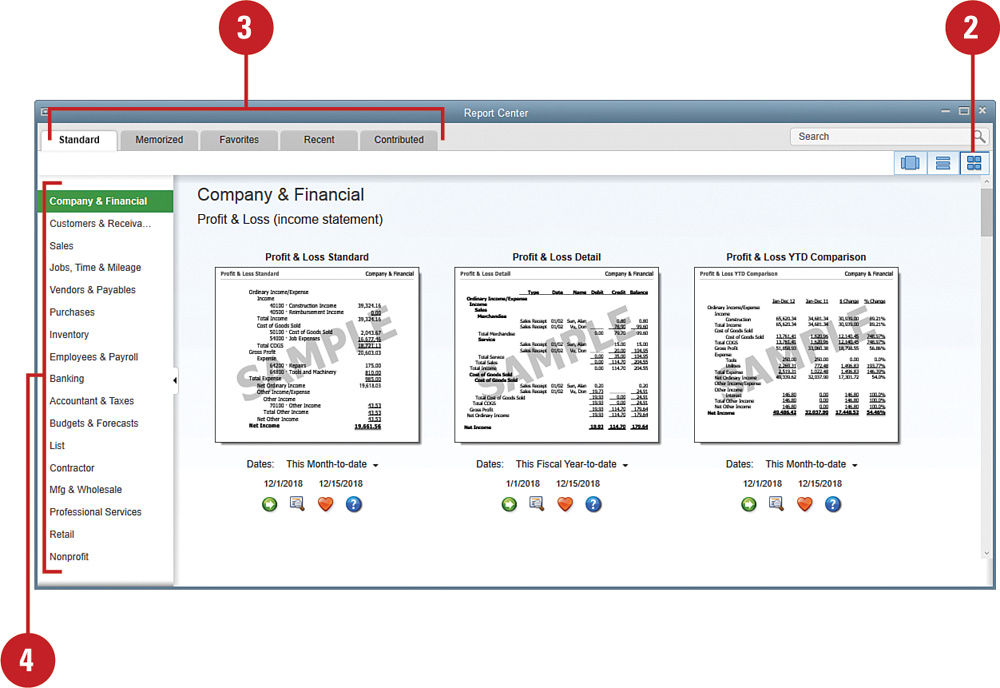
![]() Use the scrollbar to view the available reports and graphs.
Use the scrollbar to view the available reports and graphs.
![]() With a report selected, click to change the report dates.
With a report selected, click to change the report dates.
![]() Click to view a thumbnail of the report with sample data.
Click to view a thumbnail of the report with sample data.
![]() Click to display the report with your company data.
Click to display the report with your company data.
![]() Click to add to the Favorites tab of the Report Center.
Click to add to the Favorites tab of the Report Center.
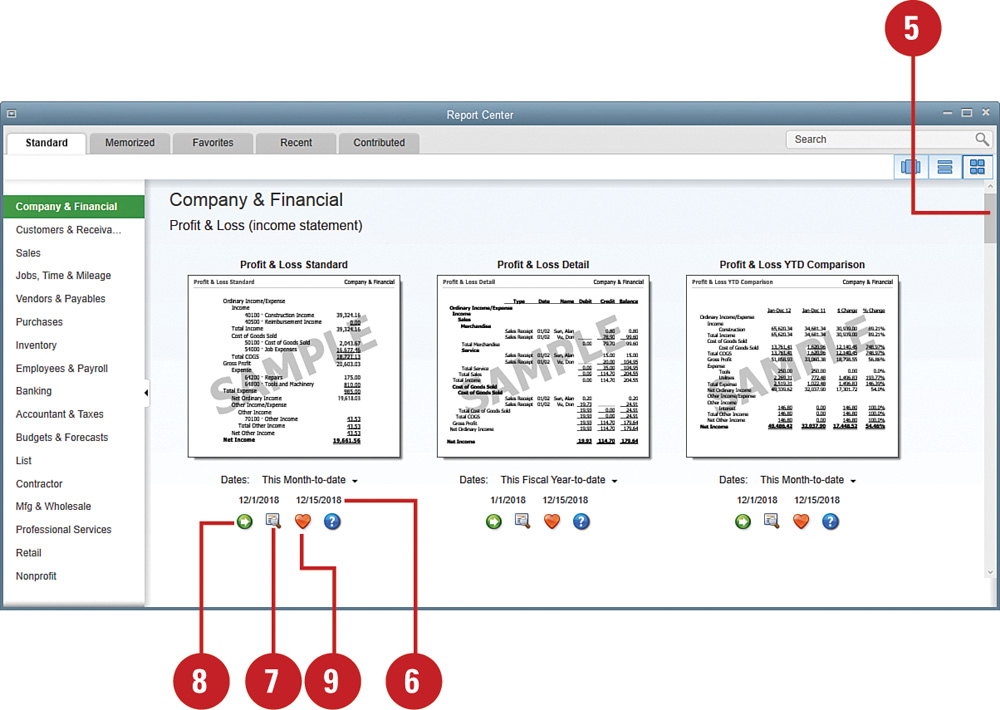
Setting Report and Graph Preferences
Make some basic decisions up front about how your reports and graphs should appear, and you won’t have to think about these choices every time you open a report. Each QuickBooks user at your company can set personal report preferences. Companywide preferences, such as text formatting and the way numbers appear, affect reports that are accessible by all users.
Set Personal Reports and Graphs Preferences
![]() Select Edit, Preferences to open the Preferences window.
Select Edit, Preferences to open the Preferences window.
![]() Click the Reports & Graphs link.
Click the Reports & Graphs link.
![]() Click the My Preferences tab.
Click the My Preferences tab.
![]() Check the Prompt Me to Modify Report check box if you always want the customizing options to appear when you view reports.
Check the Prompt Me to Modify Report check box if you always want the customizing options to appear when you view reports.
![]() Select a refresh option to indicate whether you want a report to update automatically when you make a change.
Select a refresh option to indicate whether you want a report to update automatically when you make a change.
![]() Check Draw Graphs in 2D (faster) if you like your graphs in two-dimensional style instead of the default three-dimensional.
Check Draw Graphs in 2D (faster) if you like your graphs in two-dimensional style instead of the default three-dimensional.
![]() Check Use Patterns to produce graphs in shades of black, gray, and white instead of full color. This is the best choice if you plan to print graphs on a black-and-white printer.
Check Use Patterns to produce graphs in shades of black, gray, and white instead of full color. This is the best choice if you plan to print graphs on a black-and-white printer.
![]() Click OK, or see the next task to set additional preferences.
Click OK, or see the next task to set additional preferences.

![]() Click Reports & Graphs.
Click Reports & Graphs.
![]() Click the Company Preferences tab.
Click the Company Preferences tab.
![]() Select whether to present reports on a cash basis or an accrual basis.
Select whether to present reports on a cash basis or an accrual basis.
![]() Select whether you prefer aging reports such as the Accounts Receivable Aging Report aged from the invoice due date or the transaction date.
Select whether you prefer aging reports such as the Accounts Receivable Aging Report aged from the invoice due date or the transaction date.
![]() Indicate how you want item names and descriptions displayed on reports.
Indicate how you want item names and descriptions displayed on reports.
![]() Indicate how you want account names and descriptions displayed on reports.
Indicate how you want account names and descriptions displayed on reports.
![]() Click Classify Cash to select which accounts you want to include in your Statement of Cash Flows.
Click Classify Cash to select which accounts you want to include in your Statement of Cash Flows.
![]() Click Format to make format choices for your report.
Click Format to make format choices for your report.

![]() Check off each item that should normally appear on your reports.
Check off each item that should normally appear on your reports.
![]() Enter your company name the way you want it to appear on reports.
Enter your company name the way you want it to appear on reports.
![]() Click the arrow to select from several date styles.
Click the arrow to select from several date styles.
![]() Click the arrow to select from several page styles.
Click the arrow to select from several page styles.
![]() Click the Fonts & Numbers tab to set preferences for font style and number presentation on your reports.
Click the Fonts & Numbers tab to set preferences for font style and number presentation on your reports.

![]() Click a report element from the Change Font For list.
Click a report element from the Change Font For list.
![]() Click Change Font to change the font selection for the selected title.
Click Change Font to change the font selection for the selected title.
![]() Select a preference for displaying negative numbers.
Select a preference for displaying negative numbers.
![]() Check Divided by 1000 to show report amounts divided by 1,000.
Check Divided by 1000 to show report amounts divided by 1,000.
![]() Check Except Zero Amounts to omit zero amounts from reports.
Check Except Zero Amounts to omit zero amounts from reports.
![]() Check Without Cents to display amounts without cents.
Check Without Cents to display amounts without cents.
![]() Click OK to close each of the preference windows.
Click OK to close each of the preference windows.

Modifying Reports
QuickBooks makes gathering information from your data quick and easy. Though many reports are already created and organized for your use, you might want to modify an existing report.
Display Options
![]() Display a report in your QuickBooks data using any of the instructions in the “Using the Report Center” section earlier in this chapter.
Display a report in your QuickBooks data using any of the instructions in the “Using the Report Center” section earlier in this chapter.
![]() Click Customize Report. The Display tab is shown by default. The type of information that can be modified varies depending on the report that is currently open.
Click Customize Report. The Display tab is shown by default. The type of information that can be modified varies depending on the report that is currently open.
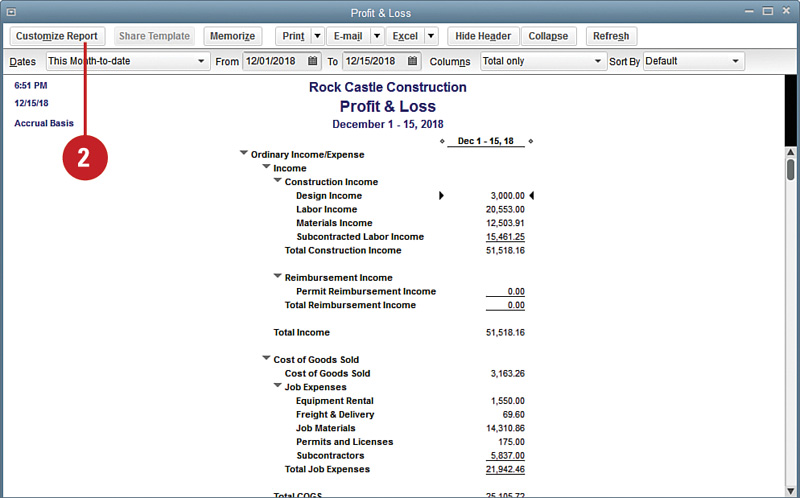
![]() Click to change the selected report dates.
Click to change the selected report dates.
![]() Click to toggle between Accrual and Cash Basis reporting. The default is set in reporting preferences.
Click to toggle between Accrual and Cash Basis reporting. The default is set in reporting preferences.
![]() Select what data you want to display in the report. This information varies greatly depending on the report that is displayed.
Select what data you want to display in the report. This information varies greatly depending on the report that is displayed.
![]() Click the Advanced button to choose which rows and columns you want to display on the report.
Click the Advanced button to choose which rows and columns you want to display on the report.
![]() Click OK to close the Advanced Options.
Click OK to close the Advanced Options.
![]() Click OK to return to the report, or click one of the other tabs to continue modifying the report.
Click OK to return to the report, or click one of the other tabs to continue modifying the report.
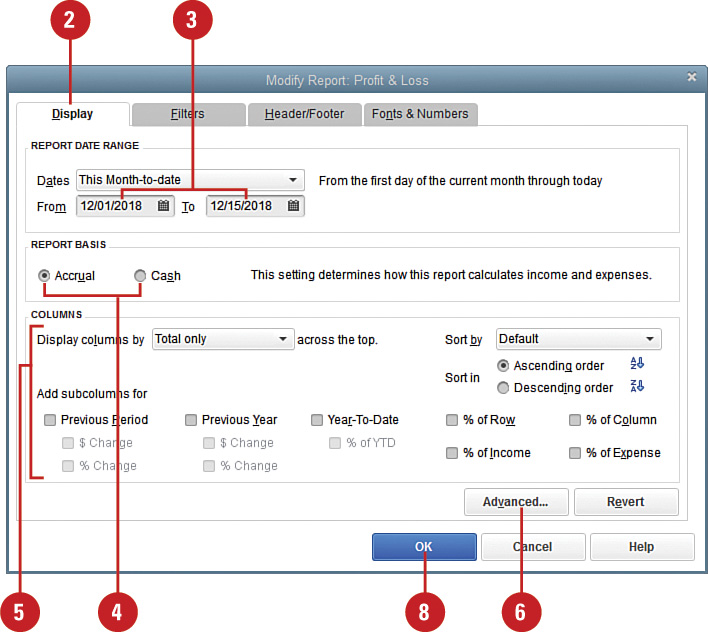

Filters Options
![]() Display a report in your QuickBooks data using any of the instructions in the “Using the Report Center” section.
Display a report in your QuickBooks data using any of the instructions in the “Using the Report Center” section.
![]() Click Modify Report. The Display tab is shown by default.
Click Modify Report. The Display tab is shown by default.
![]() Click the Filters tab.
Click the Filters tab.
![]() In the Choose Filter pane, select the specific item you want to include in the filters. The example shown is filtering for Account.
In the Choose Filter pane, select the specific item you want to include in the filters. The example shown is filtering for Account.
![]() With the item type selected to the left, click the drop-down menu or other options offered. If offered a drop-down, scroll up and down through the options available.
With the item type selected to the left, click the drop-down menu or other options offered. If offered a drop-down, scroll up and down through the options available.
![]() Review your filter choices.
Review your filter choices.
![]() To remove a filter, click the filter item and then click Remove Selected Filter.
To remove a filter, click the filter item and then click Remove Selected Filter.
![]() When you have finished setting all of your filters, click OK to return to the report, or click one of the other tabs to continue modifying the report.
When you have finished setting all of your filters, click OK to return to the report, or click one of the other tabs to continue modifying the report.

Header/Footer Options
![]() Display a report in your QuickBooks data using any of the instructions in the “Using the Report Center” section.
Display a report in your QuickBooks data using any of the instructions in the “Using the Report Center” section.
![]() Click Modify Report. The Display tab is shown by default.
Click Modify Report. The Display tab is shown by default.
![]() Click the Header/Footer tab.
Click the Header/Footer tab.
![]() Modify the Show Header Information.
Modify the Show Header Information.
![]() Modify the Show Footer Information.
Modify the Show Footer Information.
![]() Modify the alignment of the report.
Modify the alignment of the report.
![]() Click OK to return to the report, or click one of the other tabs to continue modifying the report.
Click OK to return to the report, or click one of the other tabs to continue modifying the report.

Fonts and Number Options
![]() Display a report in your QuickBooks data using any of the instructions in the “Using the Report Center” section.
Display a report in your QuickBooks data using any of the instructions in the “Using the Report Center” section.
![]() Click Modify Report. The Display tab is shown by default.
Click Modify Report. The Display tab is shown by default.
![]() Click the Fonts & Numbers tab.
Click the Fonts & Numbers tab.
![]() From the Change Font For list, select the data for which you want to change the font.
From the Change Font For list, select the data for which you want to change the font.
![]() Click the Change Font button to display the Column Labels dialog (not shown). Click OK to return to the Modify Report dialog.
Click the Change Font button to display the Column Labels dialog (not shown). Click OK to return to the Modify Report dialog.
![]() Choose how you want to display negative numbers and other display options.
Choose how you want to display negative numbers and other display options.
![]() Click OK to return to the report, or click one of the other tabs to continue modifying the report.
Click OK to return to the report, or click one of the other tabs to continue modifying the report.

Creating and Using Report Groups
If you have not set up your own customized report groups, you might not know how easy they are to work with and how efficient they can make reporting on your QuickBooks data. This section highlights how to create and use report groups.
One purpose of using report groups is the convenience of printing or displaying a batch of related reports at one time. For example, your accountant has requested that you review certain reports prior to his visit. When the requested reports are memorized and placed in a report group, you save time and are better prepared for your accountant’s review of your data because you can prepare them all at one time.
Create a Report Group
![]() Click Reports from the menu bar.
Click Reports from the menu bar.
![]() Select Memorized Reports, Memorized Report List.
Select Memorized Reports, Memorized Report List.

![]() The Memorized Report List dialog displays. Click Memorized Report, New Group.
The Memorized Report List dialog displays. Click Memorized Report, New Group.
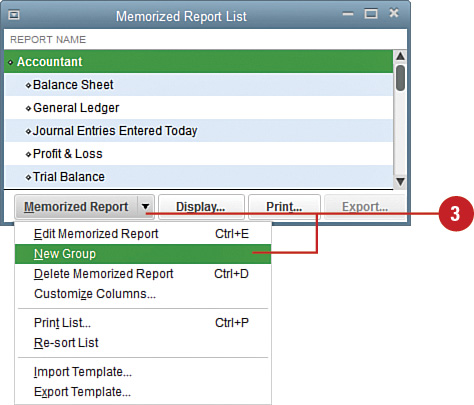
![]() Type a Name to identify the group (not shown).
Type a Name to identify the group (not shown).
![]() Click OK (not shown).
Click OK (not shown).
![]() The memorized report list displays with your newly created report group in bold type.
The memorized report list displays with your newly created report group in bold type.
![]() To exit, click the X in the top-right corner.
To exit, click the X in the top-right corner.
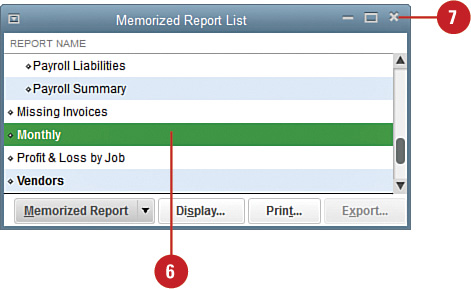
Did You Know?
If you want to store your reports to a report group, you need to first create the report group and then, when memorizing your reports (see the “Memorizing Reports” section later in this chapter), you can assign the report to a specific report group.
Use Report Groups
![]() To process a batch of related reports, click Reports and choose Process Multiple Reports.
To process a batch of related reports, click Reports and choose Process Multiple Reports.
![]() From the Process Multiple Reports dialog, click to select the group of reports you want to display or print.
From the Process Multiple Reports dialog, click to select the group of reports you want to display or print.
![]() Place a check mark to include the report or remove the check mark for those reports you do not want to run.
Place a check mark to include the report or remove the check mark for those reports you do not want to run.
![]() Modify the From and To dates if needed.
Modify the From and To dates if needed.
Important
Changing the From and To dates in the Process Multiple Reports dialog is only temporary. If you want the date change to be permanent, you need to re-create the report and memorize it again.
![]() Click an option to Display or Print.
Click an option to Display or Print.
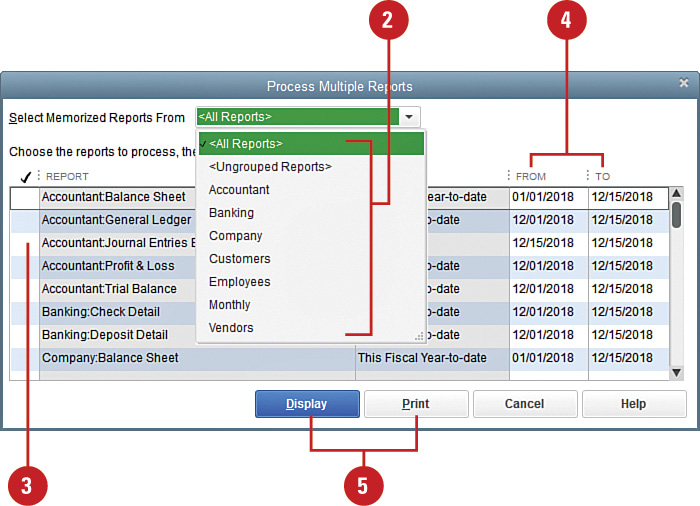
Memorizing Reports
After you have created a report group, use the memorize feature to place reports in that group. Placing your memorized reports in a group is optional, but using groups helps keep your memorized reports organized.
![]() Display a report in your QuickBooks data using any of the instructions in the “Using the Report Center” section earlier in this chapter.
Display a report in your QuickBooks data using any of the instructions in the “Using the Report Center” section earlier in this chapter.
![]() Click the Memorize button on the active report dialog.
Click the Memorize button on the active report dialog.
![]() Type a Name for the report or accept the default name.
Type a Name for the report or accept the default name.
![]() To save your report in a group, click Save in Memorized Report Group and choose the appropriate group from the drop-down menu.
To save your report in a group, click Save in Memorized Report Group and choose the appropriate group from the drop-down menu.
![]() Click OK to memorize your report and return to the displayed report.
Click OK to memorize your report and return to the displayed report.

Importing and Exporting Report Templates
QuickBooks offers the option to import and export report templates. This feature is useful for accountants who want to save time by having several clients use the same report template. You can export and import a single report or a group of reports only from the memorized report list. So before you attempt to export a report, be sure QuickBooks memorizes it first.
In addition to importing and exporting report templates, you can share templates with other QuickBooks users as explained in the next section.
Import Report Templates
![]() Click Reports, Memorized Reports, Memorized Reports List. The Memorized Report List dialog appears.
Click Reports, Memorized Reports, Memorized Reports List. The Memorized Report List dialog appears.
![]() On the Memorized Report List dialog, select Import Template from the Memorized Report drop-down menu. The Select File to Import dialog appears in Windows Explorer, enabling you to browse to the stored location of the .QBR template.
On the Memorized Report List dialog, select Import Template from the Memorized Report drop-down menu. The Select File to Import dialog appears in Windows Explorer, enabling you to browse to the stored location of the .QBR template.

![]() Select the appropriate .QBR report or report group template.
Select the appropriate .QBR report or report group template.
![]() Click Open. The Memorize Report dialog displays.
Click Open. The Memorize Report dialog displays.
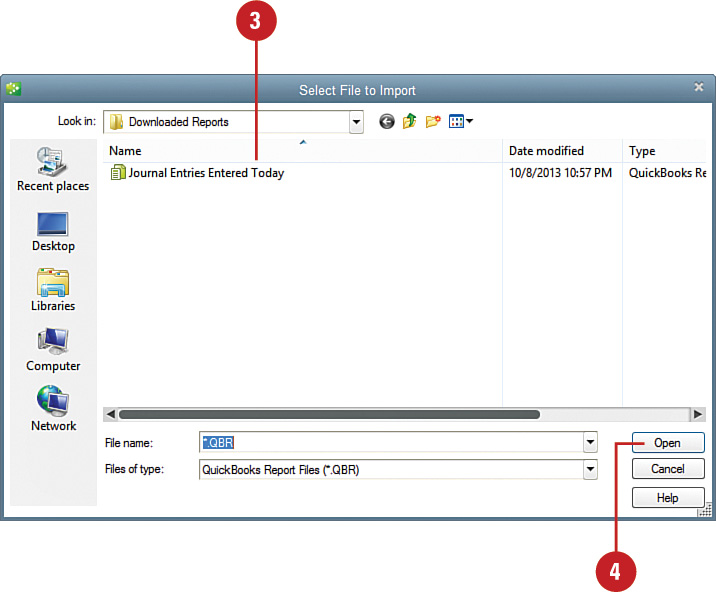
![]() Type a name for the report or accept the default report name.
Type a name for the report or accept the default report name.
![]() If you want to assign the report to a group, check the box and indicate the name of the Memorized Report Group.
If you want to assign the report to a group, check the box and indicate the name of the Memorized Report Group.
![]() If you want to share the report template with others, check the box.
If you want to share the report template with others, check the box.
![]() Click OK to add the report to your memorized report list.
Click OK to add the report to your memorized report list.
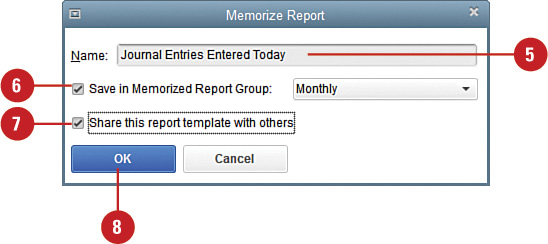
Export Report Templates
![]() Click Reports, Memorized Reports, Memorized Reports List. The Memorized Reports List dialog displays.
Click Reports, Memorized Reports, Memorized Reports List. The Memorized Reports List dialog displays.
![]() Click once to select the report on the list that you want to export.
Click once to select the report on the list that you want to export.
![]() On the Memorized Reports List dialog, select Export Template from the Memorized Report drop-down menu (not shown).
On the Memorized Reports List dialog, select Export Template from the Memorized Report drop-down menu (not shown).
![]() The Specify Filename for Export dialog displays in Windows Explorer; type a filename (or accept the default name assigned).
The Specify Filename for Export dialog displays in Windows Explorer; type a filename (or accept the default name assigned).
![]() Click Save to store the file with an extension of .QBR.
Click Save to store the file with an extension of .QBR.
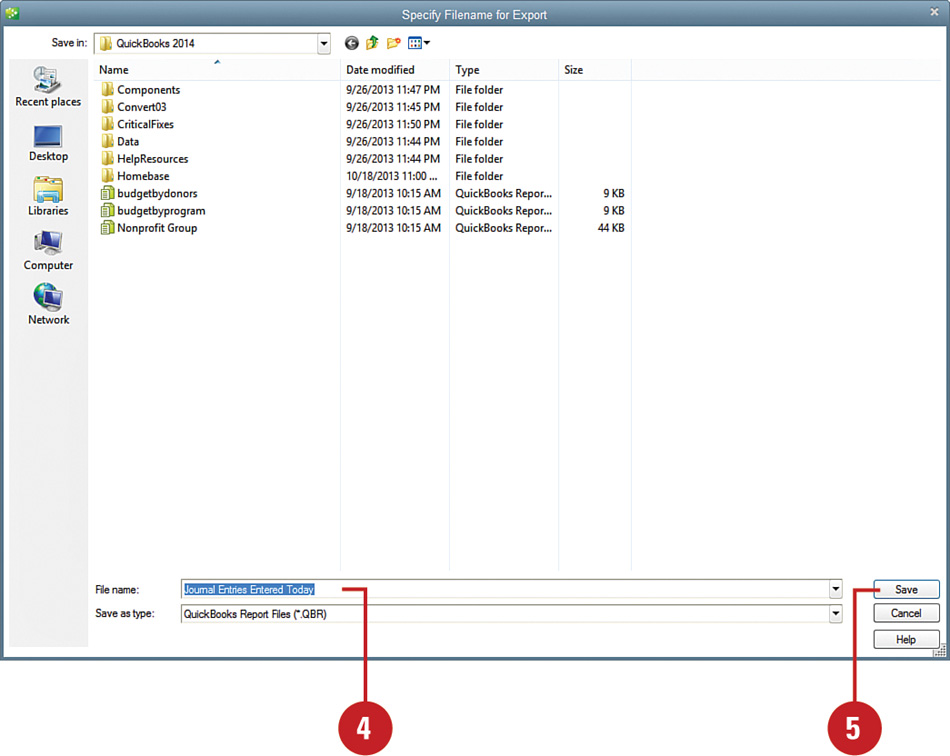
![]() To share this report with others, copy the .QBR file to a USB removable device or attach it to an email.
To share this report with others, copy the .QBR file to a USB removable device or attach it to an email.
Important
Not all reports can be exported. If the report has been customized with filters for unique list items that another data file might not have, such as a unique chart of accounts, a warning displays that the report cannot be exported.
Understanding Sharing and Contributed Reports
Contributed reports enable QuickBooks users to share customized reports (templates) with other users. Users can customize and memorize a report and then share (contribute) it for other users. Also, you might find useful reports that other people have contributed.
When you share a report, you are not sharing any financial data from your company file. You are only sharing the report structure. Before you can share a report, you need to memorize it first.
Share a Report
![]() Click Reports, Memorized Reports, Memorized Reports List. The Memorized Reports List dialog displays.
Click Reports, Memorized Reports, Memorized Reports List. The Memorized Reports List dialog displays.
![]() Double-click to select the desired report on the list that you want to share.
Double-click to select the desired report on the list that you want to share.
![]() On the top of the report, select Share Template. (Note: Share Template is grayed out if you have not memorized the report yet.)
On the top of the report, select Share Template. (Note: Share Template is grayed out if you have not memorized the report yet.)

![]() The Share Template dialog displays with the Basic Info tab opened.
The Share Template dialog displays with the Basic Info tab opened.
![]() Enter the Report Title and Description.
Enter the Report Title and Description.
![]() Enter your Name and Email.
Enter your Name and Email.
![]() Choose whether you want to share the report using your name or share anonymously.
Choose whether you want to share the report using your name or share anonymously.
![]() Click the Additional Report Info tab to provide additional information about the report you are sharing.
Click the Additional Report Info tab to provide additional information about the report you are sharing.

![]() Select the appropriate Report Type.
Select the appropriate Report Type.
![]() Select the Related Industries (scroll to see additional industries).
Select the Related Industries (scroll to see additional industries).
![]() Click Select All if the report applies to all industries.
Click Select All if the report applies to all industries.
![]() Click Share to submit the report.
Click Share to submit the report.
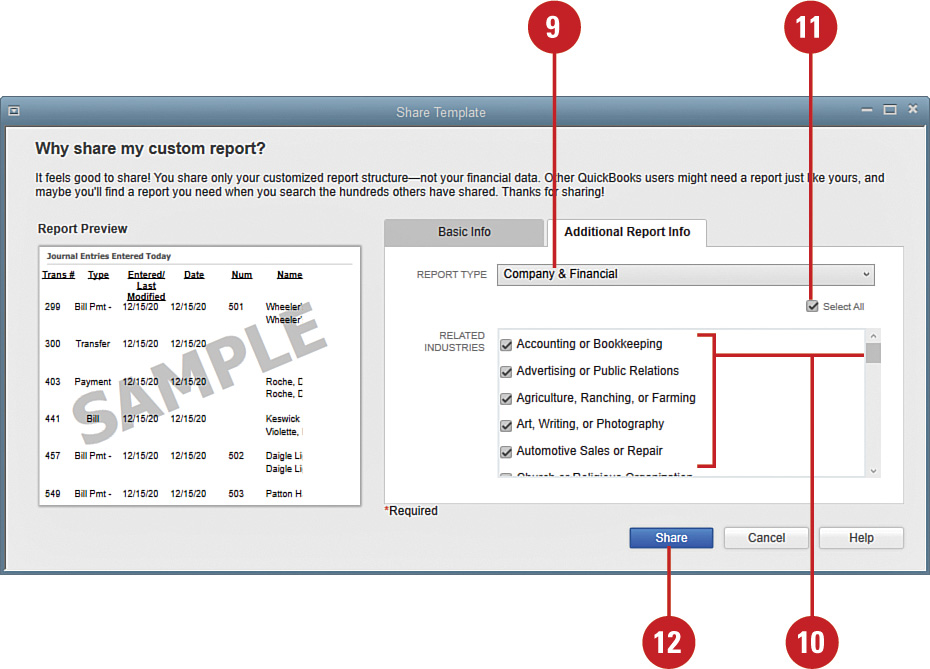
Access Contributed Reports
![]() Click Reports, Report Center, Contributed.
Click Reports, Report Center, Contributed.
![]() Select a Report Type.
Select a Report Type.
![]() Select an Industry from the drop down list.
Select an Industry from the drop down list.
![]() Select an option for Sort By.
Select an option for Sort By.
![]() Scroll through the contributed reports and double-click a report to create it.
Scroll through the contributed reports and double-click a report to create it.

Learning Other Reporting Tips and Tricks
You have learned some of the most useful tools for working with reports in QuickBooks. You might want to email your financials to your banking institution if you are applying for a loan. Or perhaps your accountant needs to do some tax planning and requests that certain reports be forwarded to him via Microsoft Excel. Or perhaps you just want to collapse the information in summary form, making it easier to analyze. Here are some useful tips and tricks for making QuickBooks even easier to use for reporting.
Email Reports
![]() To set your default preferences and text for emailing forms, select Edit, Preferences and choose the Send Forms preference.
To set your default preferences and text for emailing forms, select Edit, Preferences and choose the Send Forms preference.
![]() Click the My Preferences tab to select to send your email via Web Mail, Outlook, or QuickBooks E-mail.
Click the My Preferences tab to select to send your email via Web Mail, Outlook, or QuickBooks E-mail.
Important
You need to have a supported version of Microsoft Outlook installed on the same computer as the QuickBooks data file. Several situations that might prevent you from choosing Outlook:
![]() You are using a version of Microsoft Office that is not supported (a Click to Run or 64-bit version).
You are using a version of Microsoft Office that is not supported (a Click to Run or 64-bit version).
![]() Your profile is not set up in Microsoft Outlook.
Your profile is not set up in Microsoft Outlook.
![]() Outlook is not the default email program.
Outlook is not the default email program.
![]() Outlook is selected as the preferred email program in Internet Explorer.
Outlook is selected as the preferred email program in Internet Explorer.
![]() Click OK.
Click OK.

![]() Display a report you want to Email in your QuickBooks data using any of the instructions in the “Using the Report Center” section.
Display a report you want to Email in your QuickBooks data using any of the instructions in the “Using the Report Center” section.
![]() Click the Email drop-down menu. Select your preference to attach the report as an Excel or PDF file attachment.
Click the Email drop-down menu. Select your preference to attach the report as an Excel or PDF file attachment.

![]() If you are sending the report via Outlook, an Outlook new mail opens with the attachment (not shown). You can then use Outlook editing features before sending.
If you are sending the report via Outlook, an Outlook new mail opens with the attachment (not shown). You can then use Outlook editing features before sending.
![]() If you are sending the report via QuickBooks E-Mail, you can modify the default text assigned to the email (not shown), as defined in Step 1.
If you are sending the report via QuickBooks E-Mail, you can modify the default text assigned to the email (not shown), as defined in Step 1.
Export Reports to Excel or .csv File Format
![]() Display a report in your QuickBooks data using any of the instructions in the “Using the Report Center” section earlier in this chapter.
Display a report in your QuickBooks data using any of the instructions in the “Using the Report Center” section earlier in this chapter.
![]() Click Excel and select either Create New Worksheet or Update Existing Worksheet.
Click Excel and select either Create New Worksheet or Update Existing Worksheet.
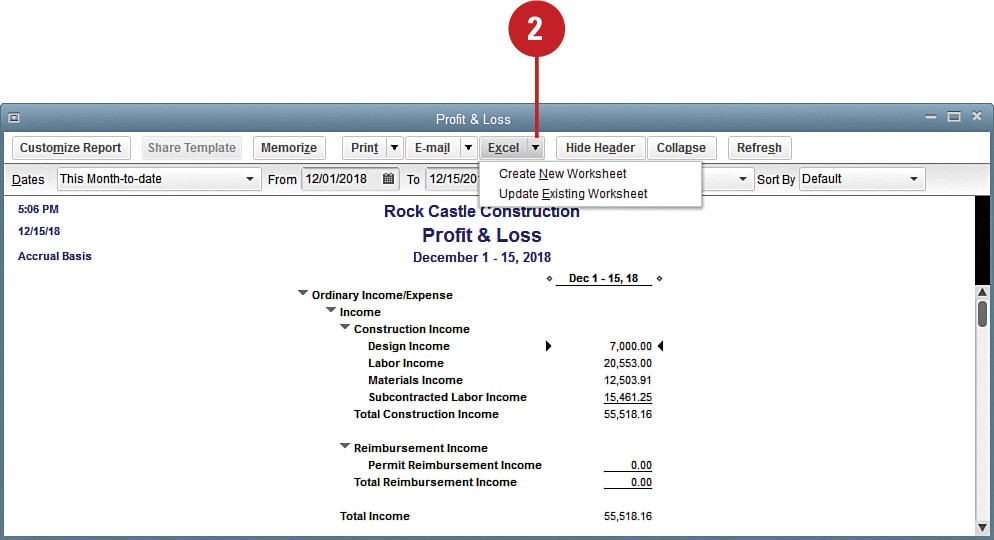
![]() Choose an export option that meets your needs.
Choose an export option that meets your needs.
![]() Click the Advanced Button for more export options (not shown).
Click the Advanced Button for more export options (not shown).
![]() Click Export to create an Excel workbook or .csv file.
Click Export to create an Excel workbook or .csv file.
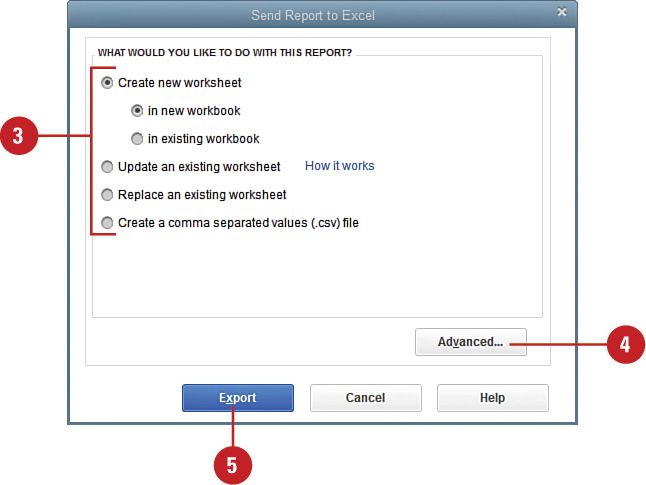
Hide Header and Collapse Details
![]() Display a report in your QuickBooks data using any of the instructions in the “Using the Improved Report Center” section earlier in this chapter.
Display a report in your QuickBooks data using any of the instructions in the “Using the Improved Report Center” section earlier in this chapter.
![]() Click Hide Header. The report dialog displays without the report header (not shown).
Click Hide Header. The report dialog displays without the report header (not shown).
![]() Click Collapse. The report displayed rolls up subaccounts into the assigned primary account.
Click Collapse. The report displayed rolls up subaccounts into the assigned primary account.


Did You Know?
If you are using QuickBooks Accountant or QuickBooks Enterprise, you can use QuickBooks Statement Writer (QSW). QSW combines the flexibility and ease of Microsoft Excel with real-time links to your QuickBooks accounting data so you can save time when creating customized financial statements.
